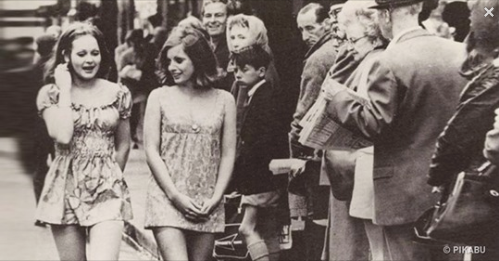Addressing Underrepresentation: A Call For Authentic Asian And Asian American Stories

Table of Contents
The Current Landscape of Asian and Asian American Representation
Stereotypes and Tropes
The portrayal of Asians and Asian Americans in media has long been plagued by harmful stereotypes, limiting and misrepresenting the complexity of their identities. These persistent tropes often reduce individuals to one-dimensional caricatures, hindering genuine understanding and empathy.
- The Model Minority: This stereotype portrays all Asians as academically gifted, hardworking, and docile, ignoring the struggles and diversity within the community. Examples include the overrepresentation of Asian characters as scientists or engineers, often lacking personality beyond their professional achievements. This ignores the socioeconomic disparities and challenges faced by many within the Asian community.
- The Perpetual Foreigner: This trope casts Asian characters as outsiders, never fully integrated into American society, regardless of their citizenship status. This is often reinforced through accents, limited English proficiency, or storylines centered around their "foreignness." This can create a sense of otherness and exclusion.
- The Submissive Woman: Asian women are frequently depicted as demure, subservient, or hypersexualized, reducing their complexity to stereotypical tropes. Examples include the "lotus blossom" archetype or the fetishization of Asian women in media. This reinforces harmful gender stereotypes and objectification.
The perpetuation of these stereotypes reinforces prejudice, fuels discrimination, and limits the opportunities for authentic representation of Asian and Asian American experiences.
Lack of Diversity within the Asian and Asian American Community
The Asian community encompasses a vast array of cultures, nationalities, and experiences. From East and Southeast Asia to South Asia, the diversity is immense. A single, monolithic portrayal fails to capture this rich tapestry.
- The differences between Korean, Chinese, Vietnamese, Indian, Japanese, and Filipino cultures, to name a few, are substantial. Each has its unique history, traditions, and societal norms.
- Ignoring this diversity results in a flattened, inaccurate portrayal, undermining the individual identities and experiences of Asian and Asian American individuals. It also reinforces the notion of a homogenous "Asian" identity, which doesn't exist.
The Importance of Authentic Representation
Fostering Understanding and Empathy
Authentic Asian and Asian American stories are crucial for breaking down stereotypes and fostering genuine understanding and empathy between communities.
- Seeing oneself reflected positively in media fosters a sense of belonging and self-esteem. It validates individual identities and experiences, which is especially important for young people seeking representation.
- Counter-narratives that challenge harmful stereotypes are essential in changing public perception and combating prejudice. These stories showcase the full spectrum of human experiences within the Asian and Asian American community.
Empowering Asian and Asian American Voices
Giving Asian and Asian American creators the platforms and resources to tell their own stories is paramount. This means actively seeking out and amplifying their voices, not just passively including them as token figures.
- Successful examples like the show "Everything Everywhere All at Once" showcase the power of authentic storytelling when creators from the community are given creative control.
- However, many Asian and Asian American creators still face significant challenges in breaking into mainstream media, encountering systemic biases and a lack of opportunities.
How to Promote Authentic Asian and Asian American Stories
Supporting Independent Artists and Filmmakers
Seeking out and supporting independent films, shows, and books featuring authentic Asian and Asian American stories is a direct way to promote meaningful change.
- Platforms like IndieWire, Film Independent, and various film festivals often highlight diverse and independent voices.
- Supporting independent creators ensures that their stories get the visibility they deserve, amplifying diverse perspectives and challenging mainstream narratives.
Demanding Better Representation from Mainstream Media
We must actively demand better representation from major studios and networks. This requires a collective effort to hold media companies accountable for their portrayals of Asian and Asian Americans.
- Write letters to studios and networks expressing your concerns and demanding more inclusive casting and storylines.
- Sign petitions and participate in social media campaigns advocating for authentic representation.
- Practice critical media consumption – question stereotypes and tropes whenever you see them, encouraging discussions and raising awareness.
Conclusion
The underrepresentation of authentic Asian and Asian American stories in mainstream media is a persistent problem with harmful consequences. We've explored the prevalent stereotypes, the importance of diverse and accurate portrayal, and actionable steps towards change. By supporting independent creators, demanding better representation from mainstream media, and engaging in critical media consumption, we can collectively amplify authentic Asian and Asian American voices and work towards a more inclusive and equitable media landscape. Let's actively seek out and celebrate Authentic Asian and Asian American Stories, sharing these narratives widely to promote understanding and foster a more just and representative world. Share this article and continue the conversation – together, we can make a difference.

Featured Posts
-
 Public Outcry Over Fabers Decision On Coa Volunteer Honours
May 12, 2025
Public Outcry Over Fabers Decision On Coa Volunteer Honours
May 12, 2025 -
 Automated Visual Inspection Of Lyophilized Vials Challenges And Solutions
May 12, 2025
Automated Visual Inspection Of Lyophilized Vials Challenges And Solutions
May 12, 2025 -
 Improving The Accuracy Of Automated Visual Inspection For Lyophilized Vials
May 12, 2025
Improving The Accuracy Of Automated Visual Inspection For Lyophilized Vials
May 12, 2025 -
 Isaiah Salinda And Kevin Velo 58 And Leading At The Zurich Classic
May 12, 2025
Isaiah Salinda And Kevin Velo 58 And Leading At The Zurich Classic
May 12, 2025 -
 Patricky Freire Targets Jose Aldo A Bellator Champions Next Challenge
May 12, 2025
Patricky Freire Targets Jose Aldo A Bellator Champions Next Challenge
May 12, 2025
Latest Posts
-
 Cobra Les Regrets De Sylvester Stallone Sur Un Classique Des Annees 80
May 12, 2025
Cobra Les Regrets De Sylvester Stallone Sur Un Classique Des Annees 80
May 12, 2025 -
 Who Is Debbie Elliott
May 12, 2025
Who Is Debbie Elliott
May 12, 2025 -
 Le Role De Stallone Dans Le Thriller Des Annees 80 Regrets Et Reflexions
May 12, 2025
Le Role De Stallone Dans Le Thriller Des Annees 80 Regrets Et Reflexions
May 12, 2025 -
 A Prevented Disaster Sylvester Stallones Almost Made Crime Thriller Sequel
May 12, 2025
A Prevented Disaster Sylvester Stallones Almost Made Crime Thriller Sequel
May 12, 2025 -
 Debbie Elliott Biography And Career Highlights
May 12, 2025
Debbie Elliott Biography And Career Highlights
May 12, 2025
